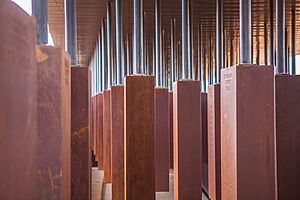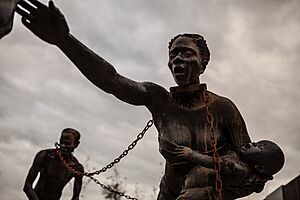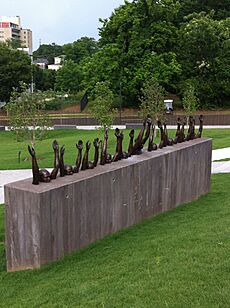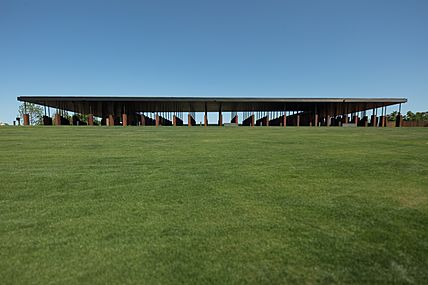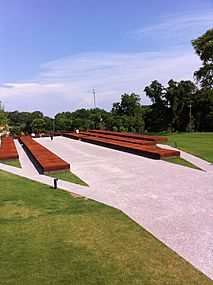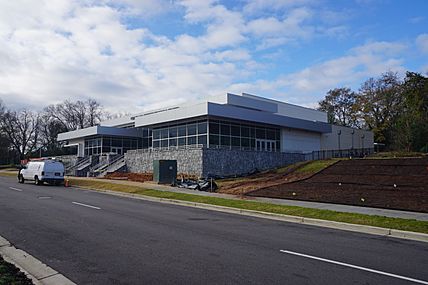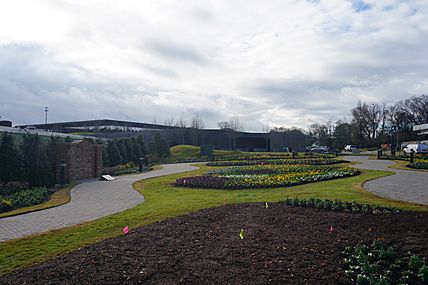National Memorial for Peace and Justice facts for kids
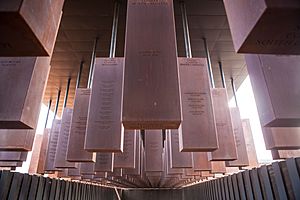
The memorial includes 805 hanging steel rectangles, representing each of the counties in the United States where a documented lynching took place
|
|
| Coordinates | 32°22′19″N 86°18′46″W / 32.37194°N 86.31278°W |
|---|---|
| Location | Montgomery, Alabama |
| Opening date | April 26, 2018 |
| Equal Justice Initiative | |
The National Memorial for Peace and Justice is a special place that remembers the many Black Americans who were victims of lynching. It is also known as the National Lynching Memorial. This memorial helps us understand past unfair treatment and encourages everyone to work for fairness in America today.
The memorial was created by a group called the Equal Justice Initiative (EJI). It opened in Montgomery, Alabama, on April 26, 2018. The main part of the memorial has 805 hanging steel rectangles. Each one stands for a county in the U.S. where a lynching was recorded. The memorial also features sculptures that show different parts of this history.
Many people, including art experts and activists, have praised the memorial. Philip Kennicott from The Washington Post called it "one of the most powerful and effective new memorials created in a generation."
Contents
Why Was the Memorial Built?
The National Memorial for Peace and Justice was built by the Equal Justice Initiative (EJI). It sits on a six-acre piece of land in downtown Montgomery, Alabama. The memorial opened to the public on April 26, 2018.
It is connected to the Legacy Museum: From Enslavement to Mass Incarceration. This museum opened on the same day. It is near a place in Montgomery where enslaved people were once sold. EJI hopes the memorial will help communities across the nation learn about racial injustice. They want people to understand their own local histories.
The memorial focuses on the history of racial terror lynchings. It also covers racial segregation, known as Jim Crow. It even connects to current issues of unfairness and police actions. The six-acre site includes sculptures by artists like Kwame Akoto-Bamfo, Dana King, and Hank Willis Thomas. You can also find writings from important people like Toni Morrison, Elizabeth Alexander, and Dr. Martin Luther King Jr. There is a quiet space to think, honoring Ida B. Wells.
The biggest part of the memorial is the memorial square. It was designed based on EJI's study, Lynching in America: Confronting the Legacy of Racial Terror. The square has 805 steel beams hanging in the air. Each beam represents a county where a racial terror lynching happened and was recorded. These six-foot beams have the names of victims of racial terrorism, including lynching. If a victim's name is unknown, that is also noted on the beams.
The memorial also has copies of these steel beams. These copies are part of EJI's Community Remembrance Project. The goal is for communities to claim their beam and create their own local memorials.
Building the memorial and its related museum cost about $20 million. This money came from private groups. Bryan Stevenson, who started EJI, was inspired by other memorials. He looked at the Memorial to the Murdered Jews of Europe in Berlin, Germany, and the Apartheid Museum in Johannesburg, South Africa. He wanted to create a single memorial for victims of white supremacy in the United States.
EJI's study, Lynching in America: Confronting the Legacy of Racial Terror, took many years. Researchers looked at records in counties across the United States. They found almost 4,400 racial terror lynchings. These happened between 1877 and 1950, mostly in the South. Most took place around the turn of the 20th century.
What Does the Memorial Look Like?
At the center of the memorial is a square with 805 hanging steel rectangles. They are shaped like coffins. These rectangles name and represent each county where a documented lynching took place. This information comes from the EJI study, Lynching in America: Confronting the Legacy of Racial Terror (2017).
Each steel plate has the names of the recorded lynching victims. If a name is not known, it says "unknown." More than 4,075 lynchings of Black people were recorded between 1877 and 1950. Most of these happened in 12 Southern states. EJI has also shared information about lynchings in some states outside the South. This monument is the first major work in the U.S. to name and honor these victims.
The main memorial was designed by MASS Design Group. It was built on land bought by EJI. Hank Willis Thomas created a sculpture called Rise Up. It shows a wall with statues of Black heads and bodies. Their arms are raised, as if surrendering. This artwork helps people see and focus on the subject. It also comments on police actions that happened before the memorial was built. Thomas has said that his art asks questions.
Outside the monument, there are benches where visitors can sit and think. These benches honor activists like journalist Ida B. Wells. In the 1890s, she bravely reported that lynchings were often about economic competition, not actual crimes.
On the ground, there are steel columns laid out in rows. These columns match the ones hanging in the memorial. These ground columns are meant to be temporary. The Equal Justice Initiative is asking representatives from each county to claim their column. They want communities to set up a memorial at home for lynching victims. They also want them to teach the public about this history. Placing these monuments is the final step of EJI's Community Remembrance Project. A memorial beam is placed when a community has talked about racial violence, both past and present. EJI hopes these local monuments will remind communities to deal with their painful history. They also want them to challenge injustice today and promise not to repeat past violence.
A month after the memorial opened, the Montgomery Advertiser newspaper reported something interesting. Citizens in Montgomery County were thinking about asking for their column. Both county and city officials were discussing this idea.
Artworks at the Memorial
The Nkyinkyim Sculpture by Kwame Akoto-Bamfo
The memorial has three main sections. The first section tells the story of African Americans' lives, starting with the difficult journey of the Middle Passage. Visitors first see a sculpture by Ghanaian artist Kwame Akoto-Bamfo. It is called Nkyinkyim, which means "twisted." This name comes from a Ghanaian saying that "life is a twisted journey."
The sculpture shows seven shackled figures of all ages and genders, linked together. This artwork is part of a bigger project Akoto-Bamfo started in Accra, Ghana. There, he makes clay busts of formerly enslaved people. He does this to help remember them and their lives. This is a common tradition among the Akan people in Ghana.
During the Middle Passage, people lost their African identity. They lost their names, their family connections, and their ethnic groups. The Nkyinkyim sculptures include details about each shackled person. Akoto-Bamfo's sculptures aim to give these identities back. They describe the figures as "Daughter of a Royal," "Uncle’s Brother," or "The Lost Guardian."
The Guided by Justice Sculpture by Dana King
American artist Dana King created Guided by Justice. This sculpture shows the Montgomery Bus Boycott during the Civil Rights Movement. It features three women: a grandmother, a teacher, and a pregnant woman. There are footprints on the ground near them. These footprints invite others to join their cause.
King's sculpture wants viewers to think differently about the heroes of the bus boycott. Sometimes, focusing only on famous figures like Rosa Parks makes us forget the thousands of other Black people who helped the boycott succeed. The three unnamed figures and the footprints show how important these "silent activists" were.
The Raise Up Sculpture by Hank Willis Thomas
As you continue through the memorial, you will see Hank Willis Thomas's sculpture Raise Up. This artwork shows policing in America. The sculpture has ten Black men, partly covered in concrete. Some have their heads lowered into the concrete, with their hands up and eyes closed.
This sculpture powerfully shows the experiences of Black men in America when they meet law enforcement. Thomas covers these Black men in concrete, making them unable to move. Some figures' heads are also lowered, showing how little control Black people have over their own bodies. Even though most of their bodies are covered, their hands are clear. This refers to stories of unarmed Black men being harmed by police, even when they were innocent. The National Memorial uses Thomas’s sculpture to connect to today's world. It reminds us that the fight for fairness and freedom is still happening.
Why the Memorial is Important for Montgomery
Before the 1990s, Montgomery did not have many public reminders of slavery and racism. The city had many monuments related to the Confederacy, often put up by private groups. Since then, the city has created a Civil Rights trail. This trail marks events like the 1965 Selma to Montgomery marches. It also points out buildings and places linked to slavery, like the old market site.
When the monument opened, New York Times named Montgomery its Top 2018 Destination. Lee Sentell from the Alabama Department of Tourism said the National Memorial offers a different and powerful experience. He noted that most museums are calm, but this one is "aggressive, political." He added that it tells a part of American history that has never been shown so directly. Mayor Todd Strange felt the memorial offered "our nation's best chance at reconciliation."
The opening events in May 2018 brought thousands of people to Montgomery, maybe as many as 10,000. Famous artists like Stevie Wonder, Patti LaBelle, and Usher performed. Speakers included U.S. Congressman and civil rights movement activist John Lewis from Georgia.
The publishers of the Montgomery Advertiser newspaper were moved by the memorial. They looked back at their past news coverage of lynchings. They formally apologized for their historical reporting, which was often unfair to Black victims. They called it "our shame" and said "we were wrong."
The memorial and its museum are expected to bring more visitors to Montgomery. This type of travel is sometimes called dark tourism, where people visit places linked to sad historical events. The Atlanta Journal-Constitution noted that with the memorial and museum, Montgomery and Atlanta together tell a story of African-American history. Atlanta has sites related to Civil Rights leader Rev. Martin Luther King Jr.. Tourism officials believe the memorial could bring 100,000 extra visitors each year.
The Legacy Museum
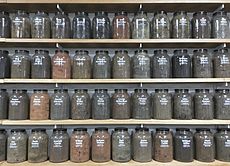
The Legacy Museum: From Enslavement to Mass Incarceration opened on the same day as the outdoor memorial. This museum shows and explains the history of slavery and racism in America. It also focuses on the large number of people in prison today and racial unfairness in the justice system.
The museum features artwork by artists like Hank Willis Thomas, Glenn Ligon, Jacob Lawrence, Elizabeth Catlett, Titus Kaphar, and Sanford Biggers. One of its displays is a collection of soil from lynching sites across the United States. This is part of EJI's Community Remembrance Project. This exhibit shows how slavery, lynchings, and unfair treatment of Black people affected many states. The museum is 11,000 square feet and includes spoken stories, old documents, and interactive technology.
Gallery
See also
- List of lynching victims in the United States
- List of museums focused on African Americans
- National Museum of African American History and Culture
- Topography of Terror, a museum in Berlin dedicated to the victims of the Nazi regime


